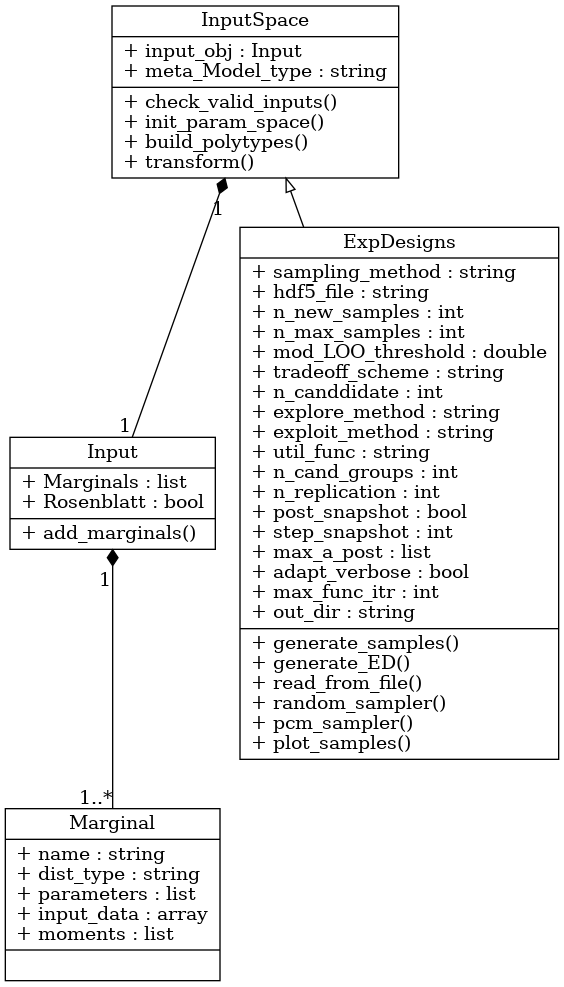Priors, input space and experimental design¶
The surrogate models, as used in BayesValidRox, consider model formulations where at least one of the input parameters is associated with uncertainty. This uncertainty can be described as probability distributions over possible values for the parameters.
Four classes contained in bayesvalidrox are associated with describing uncertain inputs: bayesvalidrox.surrogate_models.inputs.Marginal, bayesvalidrox.surrogate_models.inputs.Input, bayesvalidrox.surrogate_models.input_space.InputSpace and bayesvalidrox.surrogate_models.exp_designs.ExpDesigns.
Uncertain parameters are specified via their marginal distributions in bayesvalidrox.surrogate_models.inputs.Marginal objects as either distribution types with associated parameters, or via a set of realizations.
Supported distribution types include unif, norm, gamma, beta, lognorm, expon and weibull.
All marginals contained in an bayesvalidrox.surrogate_models.inputs.Input object should be defined in the same manner, mixing definitions via distribution type and sampels is not supported.
If rosenblatt is set as True, then a Rosenblatt transform will be applied for training the surrogate.
Note
When using a polynomial-type surrogate setting rosenblatt to True results in all hermite polynomials.
If all uncertain parameters are specified as samples, the corresponding polynomials are automatically calculated following an aPCE.
The bayesvalidrox.surrogate_models.input_space.InputSpace checks the validity of the given marginals and builds the input space.
This includes sampling from the distributions and applying the Rosenblatt transform or an isoprobabilistic transformation.
The class bayesvalidrox.surrogate_models.input_space.InputSpace is used mainly in the surrogate model.
The class bayesvalidrox.surrogate_models.exp_designs.ExpDesigns additionally contains methods and attributes related to sampling from the input space for static and iterative training of the surrogate model.
Supported sampling methods include random, latin-hypercube, sobol, halton, hammersley, chebyshev(FT), grid(FT) and user for user-defined sampling.
The options for iterative metamodel training are detailed in Active learning: iteratively expanding the training set.
Example¶
In practice, only the classes bayesvalidrox.surrogate_models.inputs.Input and bayesvalidrox.surrogate_models.exp_designs.ExpDesigns are directly used.
>>> from bayesvalidrox import Input, ExpDesign
Marginals of uncertain parameters can be directly added and defined on an Input object.
>>> inputs = Input()
If they are defined via distribution types, the name, dist_type and parameters for the distribution should be set.
>>> inputs.add_marginals(name='$X$', dist_type ='unif', parameters=[-5,5])
If they are given from data, only name and input_data are relevant.
>>> inputParams = np.random.uniform(-5,-5,100)
>>> inputs.add_marginals(name='$X$', input_data=inputParams)
An experimental design can be constructed based on these inputs.
>>> exp_design = ExpDesigns(inputs)
Samples of the marginals can be created by specifying a sampling method and generating the wanted number of samples.
>>> exp_design.sampling_method = 'latin_hypercube'
>>> samples = exp_design.generate_samples(100)
